Representing Identity: The Importance of Literature and the Translanguaging Space for EAL/D Early Years Literacy Learning
Abstract
1. Introduction
- (a)
- Explore the extent to which professional learning on creating identity texts in the translanguaging space might bring about change in the classroom practices of primary teachers and create space for EAL/D students’ languages and identities to be valued and shared, and
- (b)
- Understand how teachers navigate any emergent tensions between innovation and the routinised ‘this is how we do things’ when EAL/D Stage 2 students redesign literary texts and present their distinctive perspectives about their home country.
1.1. Translanguaging, Language and Literacy
- Supporting students as they engage with and comprehend complex content and texts.
- Providing opportunities for students to develop linguistic practices for academic contexts.
- Making space for students’ bilingualism and ways of knowing.
- Supporting students’ bilingual identities and socioemotional development (p. 7)
1.2. The Role of Literature in the Development of Language and Literacy
1.3. The Identity Text Project: ‘Identities of Competence’ and Promoting Literacy Development
2. Materials and Methods
2.1. Research Context
In the Australian Curriculum, students develop intercultural understanding as they learn to value their own cultures, languages and beliefs, and those of others. They come to understand how personal, group and national identities are shaped, and the variable and changing nature of culture. Intercultural understanding involves students learning about and engaging with diverse cultures in ways that recognise commonalities and differences, create connections with others and cultivate mutual respect [9].
2.2. Research Design and Participants
2.3. Analytical Lenses
2.3.1. Trialectic of Spatial Practices (Socio-Spatial Theory)
2.3.2. Translanguaging Space and Utilising Linguistic Repertoires
‘ … different ‘identities, values and practices … [to] combine together to create new identities, values and practices’. [It] creates a social space for the multilingual user by bringing together different dimensions of their personal history, experience and environment, their attitude, belief and ideology, their cognitive and physical capacity into one coordinated and meaningful performance’ [52] (p. 1223).
2.3.3. Redesign Cycle
2.4. Data Collection
- Site Documents: These were collected in all phases of the research and included meeting agendas and notes created by Author 2, teaching units of work, and correspondence with the school executive.
- Work Artefacts: Teacher-gathered student work samples were collected during Phase 4: (i) Venn diagram showing planning (ii) poetic redesign of Bancroft’s literary text.
- Teacher Focus Group Reflection: The focus group was audio recorded and then transcribed, including reflections on teaching programs, teaching practices prior to the collaborative professional learning, and teaching practices after the ‘Identity Text’ unit of work. Data were collected at the end of Phase 4 and were recorded during a staff meeting.
2.5. Data Analysis
3. Results
3.1. Firstspace
3.1.1. English-Only Classroom Practice
“We did some drama skits, and the kids were like ‘Yallah’ it was really, really natural to them, … they were bouncing off each other”.
“Encouraging the students to use home language which they found quite interesting and excited to use in their writing. A lot of them started to put brackets, meaning English, what it is, and they were happy to share and reflect on each other’s writing.”
3.1.2. Talk/Drama Strategies in Preparation for Writing
3.1.3. Textual Choices: Use of Literary Texts to Support Development of Identity Texts
3.2. Secondspace
- Search for strategies and resources to enhance student engagement;
- Literacy development aims;
- Desire for high-quality literacy PL.
“When it is focused on them and their history, their family obviously they’re more engaged and more inclined to talk about it”.
“Khadija … her story was like something you wouldn’t have imagined … but it was so detailed as well, and it actually got chosen by her group to be performed. It was that interesting to the, … it was a way for her to engage in writing without engaging in writing per se … She had the group there to support her to do it”.
3.3. Thirdspace
3.3.1. Naming the Problem: Understanding the Power of Texts to Position Readers
3.3.2. Imagining New Perspectives: Literary Texts That Value Identity
- (a)
- Engage with stories from their own lives and language backgrounds, for example: interviewing family members and creating readers’ theatre from family stories.
- (b)
- Read and engage critically with literary texts: What aspects of Australia/Australian life does the author tell us about? What aspects are selected for praise? How does the author show us they like/dislike aspects of Australia/Australian life? Do I agree with the author’s perspective? Is the author’s Australia the same as/different to my Australia?
- (c)
- Write a poem that redesigns one or more of the literary texts about Australia. In preparation, students respond to the prompt ‘X, my home …’. Students were given the option of employing the poetry scaffold ‘X is like …, Y is like …’ developed by Kenneth Koch in his book Wishes, Lies and Dreams [65] or appropriate stylistic patterns from one of the literary texts they had studied.
‘Lebanon my home’The Lebanon breeze is like a smooth and untouchable flowing storm.The loud music of drum beats banging and clicking across the city town of Tripoli..The enormous and deafening waves splashing and roaring along the chikka beaches …The green Cedar trees standing confident with cheer and pride!The mixed blends of tasty Kafaneh squeezing freshly into your mouth with a crunch, crunch, crunch...(Eal Stage 2)
‘Australia my heart’In Australia our fireworks go Kaboom, Kaboom, Kaboom from our spectacular Harbour BridgeSparkling glitter down the midnight sky every year.Colourful bright rides at Kuna Park looks like diamonds shinning (sic) between my brown eyesThe billowing waves crushing on the wet golden soft sandKangaroos hopping, hopping, hopping with their joeys in their pouches.(Nabel, Stage 2)
3.3.3. Promoting Improved Understanding of and Relationships with Others: Identity Texts and Translanguaging Space
Rows of trees with their vibrant leaves going side to side.Chattering under rooftops, bang the balls, pound the bright yellow fence.Red lava lights, slow tyres driving by, ticking blinkers going right and left.A beautiful double story (sic) home with comfort like a candle in the dark.(Daoud, Stage 2)
… The cold and glowing Arz snowfields where the laughter of kids are heard as they slide down the hill tops.The chirpy and energetic shopkeepers blaring out “Yalla, yall” to locals.The beautiful and peaceful city of Tripoli filled with laughter and joy.Corner shops open round the clock and shopkeeper shouting “Uhlan wa Sahlan” meaning welcome in as they do business.(Rebuz, Stage 2)
The superb Blue Mountains filled with adventure.Mayhem on the streets of Luna Park as everyone rushes to their favourite rides like hurricanes.Multiple shopping areas at every station crowded with shops and people.Melodic, thundering music filling the Opera house like elephants trumpeting in an echoey cave‘Brr, Brr, Brr’. …The billowing salty waves crash on the scorching sand as cool as it’s dangerous at the beach.Australia my country.(Araceli, Stage 2)
4. Discussion
Author Contributions
Funding
Institutional Review Board Statement
Informed Consent Statement
Data Availability Statement
Conflicts of Interest
References
- Centre for Education Statistics and Evaluation (CESE). Schools: English as an Additional Language or Dialect (EAL/D) Learners 2015 to 2019. 2021. Available online: https://education.nsw.gov.au/about-us/educational-data/cese/publications/statistics/eald-2019-statistical-bulletin (accessed on 19 January 2023).
- Dutton, J.; Rushton, K. Using the translanguaging space to facilitate poetic representation of language and identity. Lang. Teach. Res. 2021, 25, 15–133. [Google Scholar] [CrossRef]
- D’warte, J.; Rushton, K.; Abu Bakar, A. Investigating Pre-Service Teachers’ Linguistic Funds of Knowledge; Western Sydney University: Penrith, Australia, 2021. [Google Scholar] [CrossRef]
- Derewianka, B.; Jones, P. Teaching Language in Context, 2nd ed.; Oxford University Press: South Melbourne, Australia, 2016. [Google Scholar]
- Myhill, D. Grammar re-imagined: Foregrounding understanding of language choice in writing. Engl. Educ. 2021, 55, 265–278. [Google Scholar] [CrossRef]
- Cummins, J.; Early, M. (Eds.) Identity Texts: The Collaborative Creation of Power in Multilingual Schools; Trentham Books: Stoke-on-Trent, UK, 2011. [Google Scholar]
- Dutton, J.; D’warte, J.; Rossbridge, J.; Rushton, K. Tell me your story: Confirming identity and engaging writers in the middle years; Primary English Teaching Association Australia (PETAA): Sydney, Australia, 2018. [Google Scholar]
- Li, W. Who’s teaching whom? Co-learning in multilingual classrooms. In The Multilingual Turn: Implications for SLA, TESOL and Bilingual Education; May, S., Ed.; Routledge: New York, NY, USA, 2014; pp. 167–190. [Google Scholar]
- Australian Curriculum Assessment and Reporting, ACARA (n.d). Australian Curriculum. Available online: https://acara.edu.au/curriculum (accessed on 15 November 2022).
- Australian Children’s Education and Care Quality Authority. Belonging, Being and Becoming: Early Years Learning Framework for Australia. 2022. Available online: https://www.acecqa.gov.au/sites/default/files/2023-01/EYLF-2022-V2.0.pdf (accessed on 15 November 2022).
- Baker, M. Playing, talking, co-constructing: Exemplary teaching for young dual language learners across program types. Early Child. Educ. J. 2019, 45, 115–130. [Google Scholar] [CrossRef]
- Slaughter, Y.; Cross, R. Challenging the monolingual mindset: Understanding plurilingual pedagogies in English as an Additional Language (EAL) classrooms. Lang. Teach. Res. 2021, 25, 39–60. [Google Scholar] [CrossRef]
- Eades, D. Aboriginal Ways of Using English; Aboriginal Studies Press: Canberra, Australia, 2013. [Google Scholar]
- Janks, H. Literacy and Power; Routledge: London, UK, 2010. [Google Scholar] [CrossRef]
- Bancroft, B. Why I love Australia; Little Hare Books: Richmond, VIC, Australia, 2015. [Google Scholar]
- Yilmaz, T. Translanguaging as a pedagogy for equity of language minoritized students. Int. J. Multiling. 2019, 1–20. [Google Scholar] [CrossRef]
- Creese, A.; Blackledge, A. Translanguaging and identity in educational settings. Ann. Rev. Appl. Linguist. 2015, 35, 20–35. [Google Scholar] [CrossRef]
- D’warte, J.; Slaughter, Y. Introduction: Reframing language in teaching and learning: Leveraging students’ meaning-making repertoires. Lang. Teach. Res. 2021, 25, 5–11. [Google Scholar] [CrossRef]
- Oliver, R.; Wigglesworth, G.; Angelo, D.; Steele, C. Translating translanguaging into our classrooms: Possibilities and challenges. Lang. Teach. Res. 2021, 25, 134–150. [Google Scholar] [CrossRef]
- Williams, C. Secondary education: Teaching in the bilingual situation. In The Language Policy: Taking Stock; Williams, C., Lewis, G., Baker, C., Eds.; Canolfan Astudiaethau Iaith: Llangefni, Wales, UK, 1996; pp. 193–211. [Google Scholar]
- Velasco, P.; García, O. Translanguaging and the writing of bilingual learners. Biling. Res. J. 2014, 3, 6–23. [Google Scholar] [CrossRef]
- García, O.; Li, W. Translanguaging: Language, Bilingualism and Education; Palgrave Macmillan: New York, NY, USA, 2014. [Google Scholar]
- Blackledge, A.; Creese, A. Multilingualism: A Critical Perspective; Bloomsbury: London, UK, 2010. [Google Scholar]
- García, O.; Ibarra-Johnson, S.; Seltzer, K. The Translanguaging Classroom: Leveraging Student Bilingualism for Learning; Caslon: Philadelphia, PA, USA, 2017. [Google Scholar]
- D’warte, J. Facilitating agency and engagement: Visual methodologies and pedagogical interventions for working with culturally and linguistically diverse young people. Lang. Teach. Res. 2021, 25, 12–38. [Google Scholar] [CrossRef]
- Bauer, E.B.; Presiado, V.; Colomer, S. Writing Through Partnership: Fostering Translanguaging in Children Who Are Emergent Bilinguals. J. Lit. Res. 2017, 49, 10–37. [Google Scholar] [CrossRef]
- Cenoz, J.; Gorter, D. Minority languages and sustainable translanguaging: Threat or opportunity? J. Multiling. Multicult. Dev. 2017, 38, 901–912. [Google Scholar] [CrossRef]
- D’warte, J. Exploring linguistic repertoires: Multiple language use and multimodal activity in five classrooms. Aust. J. Lang. Lit. 2014, 37, 21–30. [Google Scholar] [CrossRef]
- Bernstein, B. The Structuring of Pedagogic Discourse; Routledge: London, UK, 1990. [Google Scholar] [CrossRef]
- Krashen, S. Principles and Practice in Second Language Acquisition; Prentice-Hall International: Hoboken, NJ, USA, 1987. [Google Scholar]
- Rosen, M. What Is Children’s Poetry for? Towards a New Child-Specific ‘Apologie for Poetrie’ (Philip Sidney 1579). The Philippa Pearce Memorial Lecture Presented at Homerton College, Cambridge, UK. 10 September 2009. Available online: http://www.pearcelecture.com/the-lectures/2009-2 (accessed on 23 August 2020).
- Huisman, R. Talking about poetry—Using the model of language in Systemic Functional Linguistics to talk about poetic texts. Eng. Aust. 2016, 51, 7–19. [Google Scholar]
- Duckworth, V.; Tett, L. Transformative and emancipatory literacy to empower. Int. J. Lifelong Educ. 2019, 38, 366–368. [Google Scholar] [CrossRef]
- Greene, M. Releasing the Imagination: Essay on Education, the Arts, and Social Change; Jossey-Bass: San Francisco, CA, USA, 1995. [Google Scholar]
- Hammond, J. (Ed.) What is Scaffolding? Scaffolding Teaching and Learning in Language and Literacy Education; PETAA: Newtown, Australia, 2001; pp. 1–14. [Google Scholar]
- Martin, J.; Rose, D. Genre Relations: Mapping Culture; Equinox Publishing: London, UK, 2008. [Google Scholar]
- Halliday, M.A.K. An Introduction to Functional Grammar, 4th ed.; Routledge: Milton Park, UK, 2004. [Google Scholar]
- Bishop, R. Mirrors, Windows, and Sliding Glass Doors. Perspectives: Choosing and Using Books for the Classroom, 6. 1990. Available online: https://scenicregional.org/wp-content/uploads/2017/08/Mirrors-Windows-and-Sliding-Glass-Doors.pdf (accessed on 29 August 2022).
- Choi, J.; Slaughter, Y. Challenging discourses of deficit: Understanding the vibrancy and complexity of multilingualism through language trajectory grids. Lang. Teach. Res. 2021, 25, 81–104. [Google Scholar] [CrossRef]
- D’warte, J. Mapping languages and literacies with multilingual students in Australian classrooms. Read. Teach. 2019, 72, 663–669. [Google Scholar] [CrossRef]
- Clemente, S.; Early, M. Multilingual Identity Texts in the Library Curriculum. In Identity Texts: The Collaborative Creation of Power in Multilingual Schools; Cummins, A., Early, M., Eds.; Trentham Books: Stoke-on-Trent, UK, 2011; pp. 63–71. [Google Scholar]
- Dutton, J.; Rushton, K. Drama pedagogy: Subverting and remaking, learning in the thirdspace. Aust. J. Lang. Lit. 2022. [CrossRef]
- Lambert, J. I Am Becoming More Intelligent Every Day: ‘Non-native’ English student teachers’ liberating Identity Texts. In Identity Texts: The Collaborative Creation of Power in Multilingual Schools; Cummins, J., Early, M., Eds.; Trentham Books: Stoke-on-Trent, UK, 2011; pp. 97–102. [Google Scholar]
- Anderson, J.; Chung, Y.-C.; Macleroy, V. Creative and Critical Approaches to Language Learning and Digital Technology: Findings from a Multilingual Digital Storytelling Project. Lang. Educ. 2018, 32, 195–211. [Google Scholar] [CrossRef]
- Cohen, S.; Sastri, P. Creating Picture Books and Performance as Identity Texts in a Core French Classroom. In Identity Texts: The Collaborative Creation of Power in Multilingual Schools.; Cummins, J., Early, M., Eds.; Trentham Books: Stoke-on-Trent, UK, 2011; pp. 67–71. [Google Scholar]
- Dutton, J.; Rushton, K. Confirming identity using drama pedagogy: English teachers’ creative response to high-stakes literacy testing. Engl. Aust. 2018, 53, 5–14. [Google Scholar]
- Chik, A.; Benson, P.; Moloney, R. (Eds.) Multilingual Sydney; Routledge: New York, NY, USA, 2019. [Google Scholar]
- Lo Bianco, J.; Slaughter, Y. Language policy and education in Australia. In Encyclopedia of Language and Education, Language Policy and Political Issues in Education; McCarty, T., May, S., Eds.; Springer Reference Education: Berlin, Germany, 2017; Volume 1, pp. 449–461. [Google Scholar] [CrossRef]
- D’warte, J. Recognising the bilingual meaning-making potential of young people aged six to eight years old in one Australian classroom. J. Early Child. Lit. 2020, 20, 296–326. [Google Scholar] [CrossRef]
- Lefebvre, H. The Production of Space; Blackwell: Oxford, UK, 1991. [Google Scholar]
- Soja, E. The socio-spatial dialectic. An. Assoc. Am. Geogr. 1980, 70, 207–225. [Google Scholar] [CrossRef]
- Li, W. Moment analysis and translanguaging space: Discursive construction of identities by multilingual Chinese youth in Britain. J. Pragmat. 2011, 43, 1222–1235. [Google Scholar] [CrossRef]
- Li, W. Translanguaging as a practical theory of language. App. Ling. 2018, 39, 9–30. [Google Scholar] [CrossRef]
- Janks, H. The importance of critical literacy. Eng. Teach.-Pract. Crit. 2012, 11, 150–163. Available online: http://education.waikato.ac.nz/research/files/etpc/files/2012v11n1dial1.pdf (accessed on 18 October 2022).
- Australian Curriculum Assessment and Reporting—ACARA (n.d). My School. Available online: https://www.myschool.edu.aa (accessed on 24 February 2023).
- Janks, H. Critical literacy in teaching and research. Educ. Inq. 2013, 4, 225–242. [Google Scholar] [CrossRef]
- Mantei, J.; Kervin, L. Re-examining ‘Redesign’ in Critical Literacy Lessons with Grade 6 Students. Eng. Ling. Res. 2016, 5, 83–97. [Google Scholar] [CrossRef]
- Vertovec, S. Super-diversity and its implications. Ethn. Racial Stud. 2007, 30, 1024–1054. [Google Scholar] [CrossRef]
- Manuel, J.; Carter, D.; Dutton, J. As much as love being in the classroom Understanding secondary English teachers’ workload. Eng. Aust. 2018, 53, 5–22. [Google Scholar]
- Jefferson, M.; Anderson, M. Transforming Schools: Creativity, Critical Reflection, Communication, Collaboration; Bloomsbury: Sydney, Australia, 2017. [Google Scholar]
- Janks, H. Domination, Access, Diversity and Design: A Synthesis for Critical Literacy Education. Educ. Rev. 2000, 52, 175–186. [Google Scholar] [CrossRef]
- Janks, H.; Dixon, K.; Ferreira, A.; Granville, S. Doing Critical Literacy: Texts and Activities for Students and Teachers; Routledge: New York, NY, USA, 2014. [Google Scholar]
- Braun, V.; Clarke, V. Reflecting on Reflexive Thematic Analysis. Qual. Res. Sport Exerc. Health 2019, 11, 589–597. [Google Scholar] [CrossRef]
- Saldana, J. The Coding Manual for Qualitative Researchers, 4th ed.; Sage: London, UK, 2021. [Google Scholar]
- Koch, K. Wishes, Lies, and Dreams: Teaching Children to Write Poetry; Harper Perennial: London, UK, 1999. [Google Scholar]
- Ewing, R. The imperative of an arts-led curriculum: Lessons from research. NJ-Drama Aust. J. 2012, 36, 7–14. [Google Scholar] [CrossRef]
- French, M.; Armitage, J. Eroding the Monolingual Monolith. Aust. J. Appl. Linguist. 2020, 3, 91–114. [Google Scholar] [CrossRef]
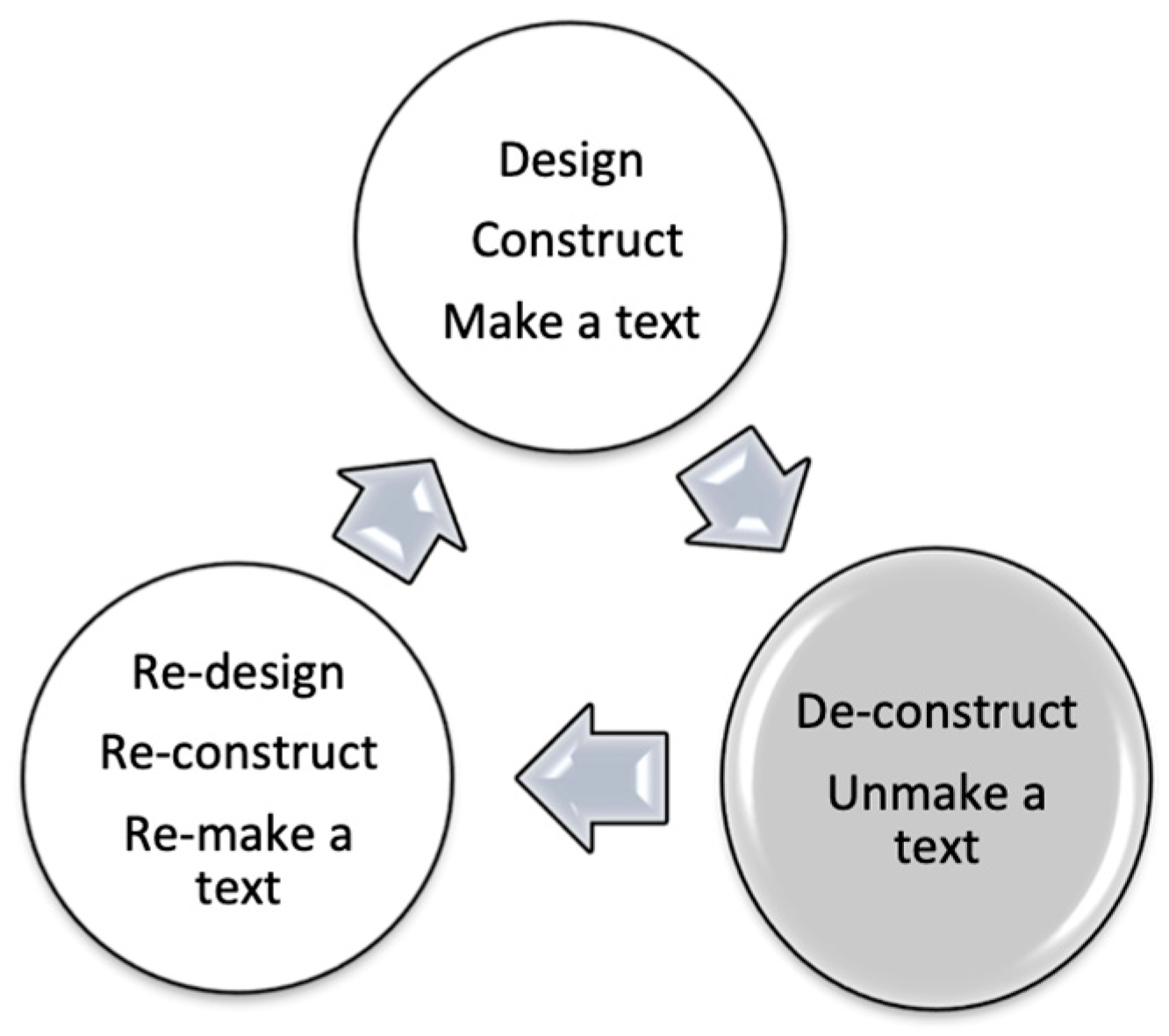
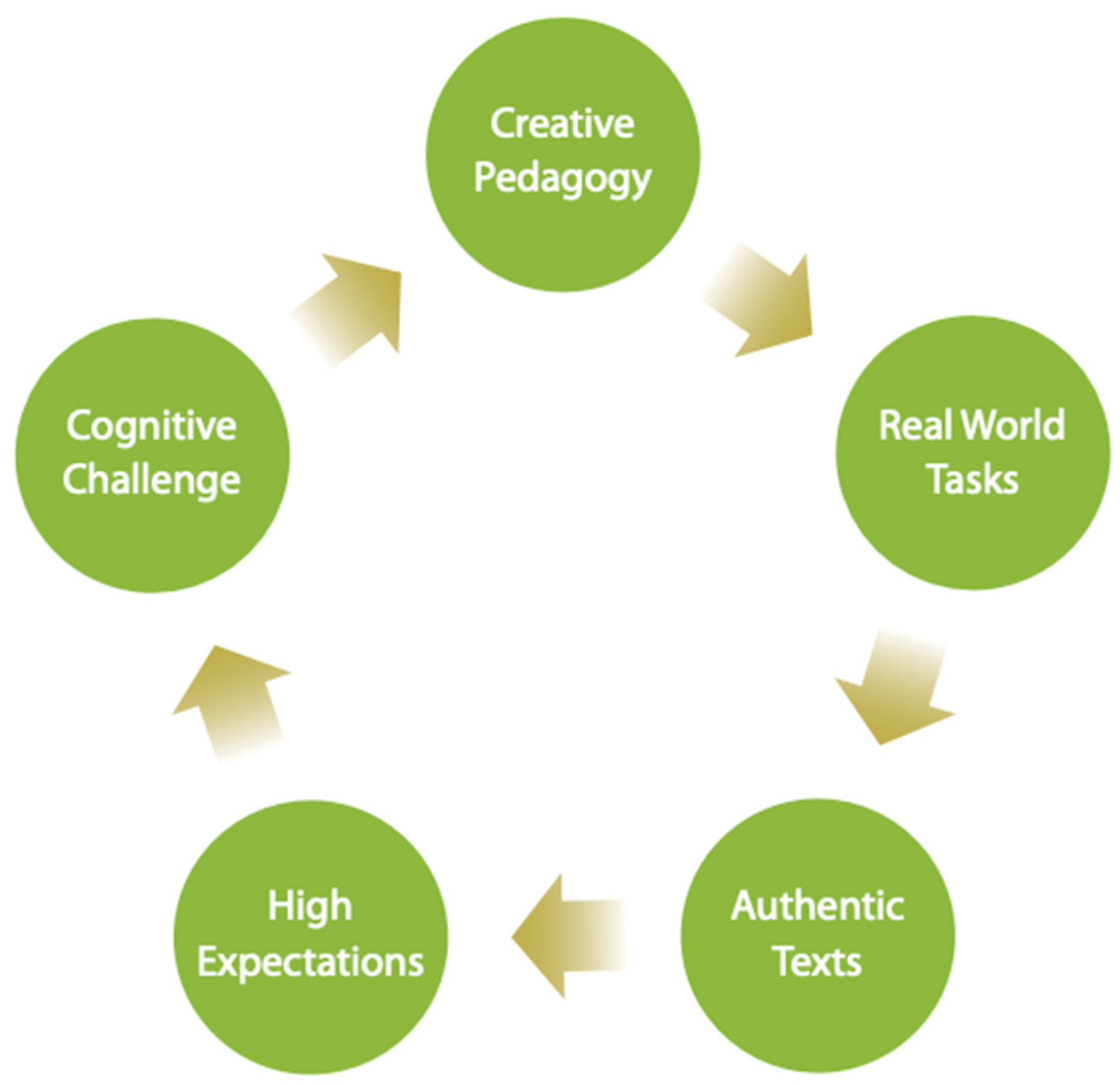
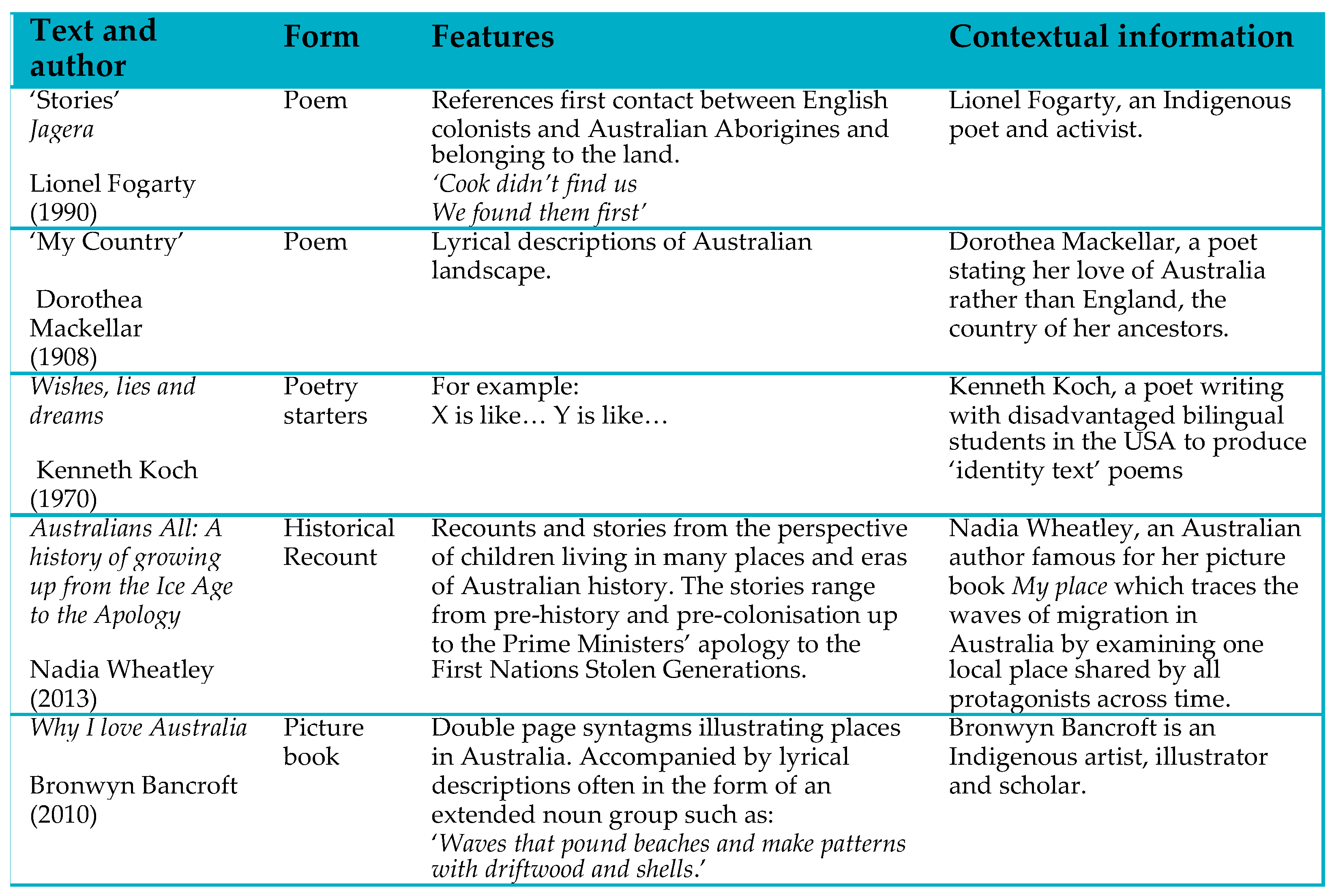
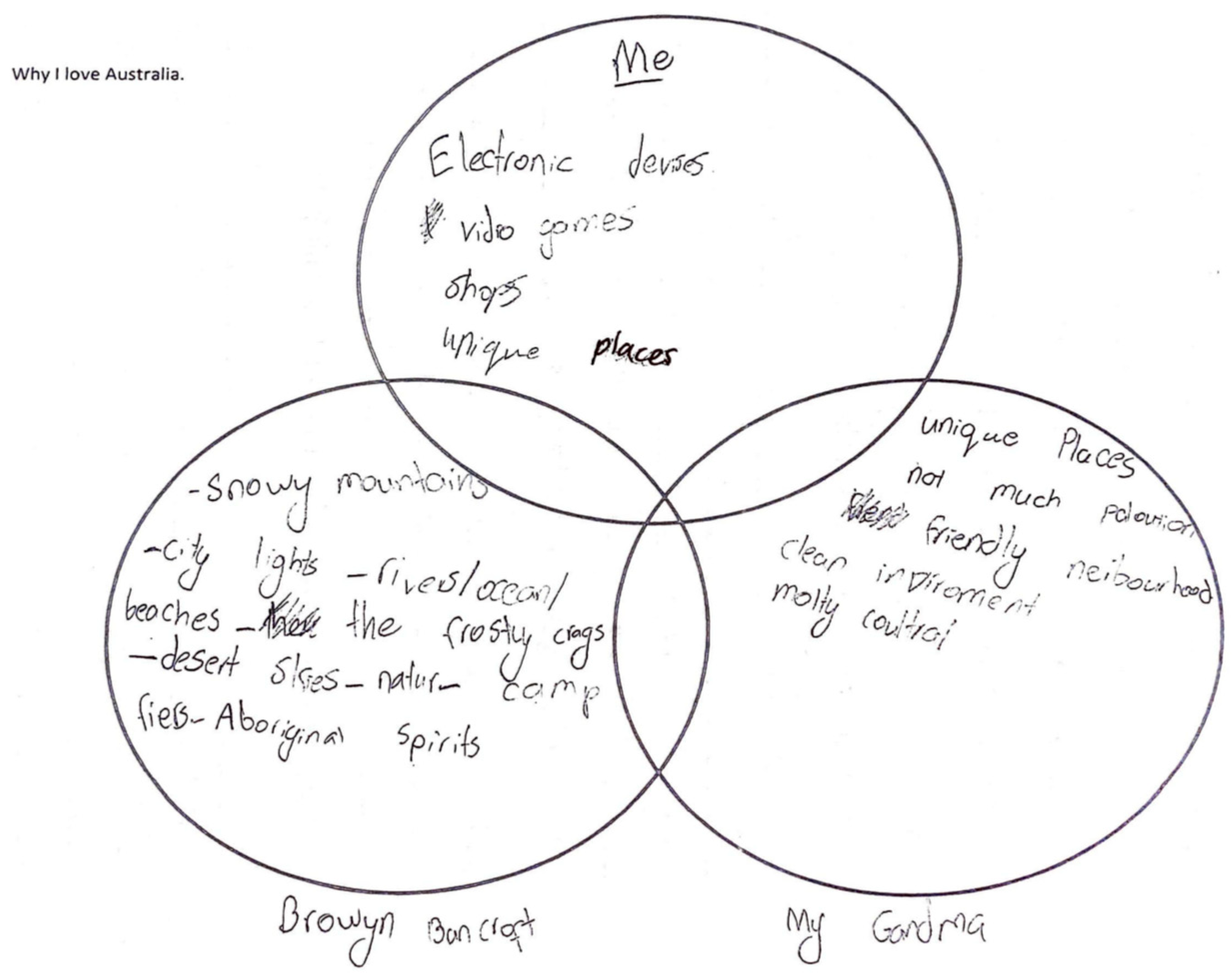
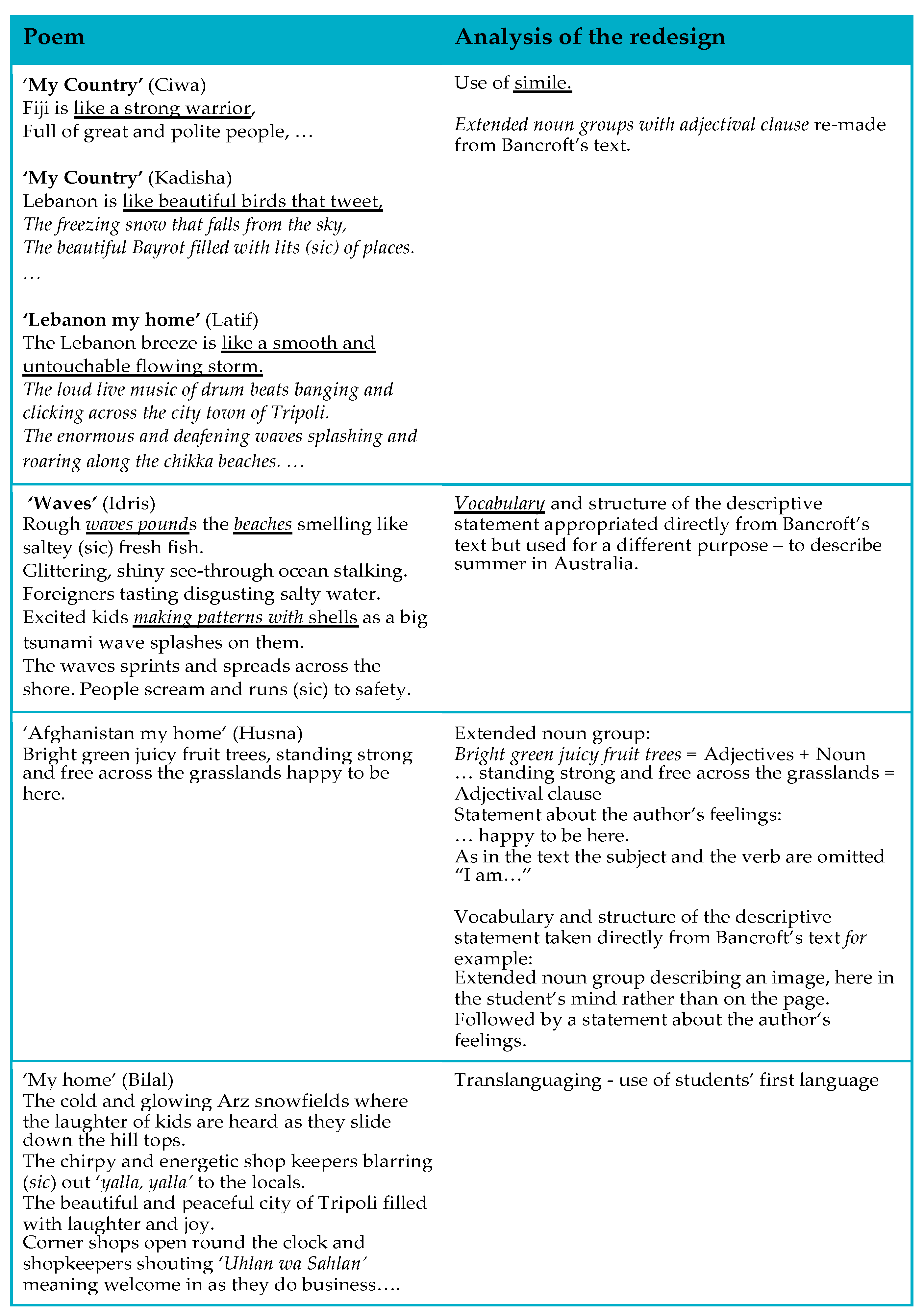

| Space | Characteristics |
|---|---|
| Firstspace | Space of everyday routines and practice Bell times, lesson arrangements, daily routines. Resource availability/constraints. Normalisation of the monolingual classroom resulting in erosion of student agency, voice Typified by tight deadlines, sometimes pragmatic decision making. No time for creative classroom practice Narrowing of curriculum and pedagogy in response to high-stakes testing and performativity pressures. This is how we usually do things. |
| Secondspace | Ideal educational setting and practice as espoused by curriculum documents, politicians, those with societal power. Commentary of critique (Mockler, 2022). Performativity measures. High-stakes testing—pressure to invoke pedagogy to improves test results Resistance to creativity Resistance to multilingual teaching and learning practices This is how you should do things. |
| Thirdspace | Transformative pedagogy: translanguaging space. Subversion and reimagination Space to “resist, subvert and reimagine everyday realities’ (Ryan and Barton, 2013, p. 73). Possibilities for an expanded form of learning and new knowledge Remaking taken for granted practices and beliefs about monolingual language practices. Identity texts. The Redesign Cycle Thirdspace practice relating to EAL/D literacy development requires intentionality of practice to be enacted What if …? |
| Element | Strategy and Resources |
|---|---|
| Creative pedagogy | Use of ‘Walk in Role’ and ‘Advance Detail’ to explore characterisation and point of view in texts. Use of poetry scaffold ‘X is like …, Y is like …’ (Koch, 1990) to support redesign of the student selected literary text representation of Australia. |
| Real world task | Interviewing family member to gather an oral narrative from home/community. |
| Authentic texts | Creation of redesigned poetry text or collaborative creation of an original script for Readers Theatre. Use of translanguaging encouraged to: - Support learning - Represent cultural background in events and dialogue |
| High expectations | Reading and critical analysis of literary texts and their perspective of Australia. Scaffolded redesign task. Student agency in authorial decisions. Realistic but defined deadlines. |
| Cognitive challenge | Transformation of medium from original picture book to poem. Redesign cycle using Why I love Australia (Bancroft). Use of textual conventions and form. |
| Theme | Subtheme |
|---|---|
| 1. Firstspace | English-only practice. Talk/drama strategies in preparation for writing. Textual choices: use of literary texts to support development of identity texts. |
| 2. Secondspace | Search for strategies and resources to enhance student engagement. Literacy development aims. Desire for high quality literacy PL. Interest in fostering community connections. |
| 3. Thirdspace | Naming the problem: understanding the power of texts to position readers. Imagining new perspectives: literary texts that value identity Promoting improved understanding of and relationships with others: connectedness to and within communities: Identity texts and translanguaging space. |
Disclaimer/Publisher’s Note: The statements, opinions and data contained in all publications are solely those of the individual author(s) and contributor(s) and not of MDPI and/or the editor(s). MDPI and/or the editor(s) disclaim responsibility for any injury to people or property resulting from any ideas, methods, instructions or products referred to in the content. |
© 2023 by the authors. Licensee MDPI, Basel, Switzerland. This article is an open access article distributed under the terms and conditions of the Creative Commons Attribution (CC BY) license (https://creativecommons.org/licenses/by/4.0/).
Share and Cite
Dutton, J.; Rushton, K. Representing Identity: The Importance of Literature and the Translanguaging Space for EAL/D Early Years Literacy Learning. Educ. Sci. 2023, 13, 569. https://doi.org/10.3390/educsci13060569
Dutton J, Rushton K. Representing Identity: The Importance of Literature and the Translanguaging Space for EAL/D Early Years Literacy Learning. Education Sciences. 2023; 13(6):569. https://doi.org/10.3390/educsci13060569
Chicago/Turabian StyleDutton, Janet, and Kathy Rushton. 2023. "Representing Identity: The Importance of Literature and the Translanguaging Space for EAL/D Early Years Literacy Learning" Education Sciences 13, no. 6: 569. https://doi.org/10.3390/educsci13060569
APA StyleDutton, J., & Rushton, K. (2023). Representing Identity: The Importance of Literature and the Translanguaging Space for EAL/D Early Years Literacy Learning. Education Sciences, 13(6), 569. https://doi.org/10.3390/educsci13060569







